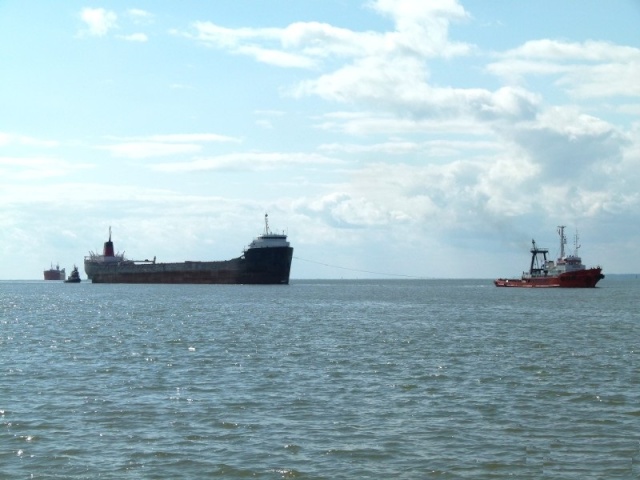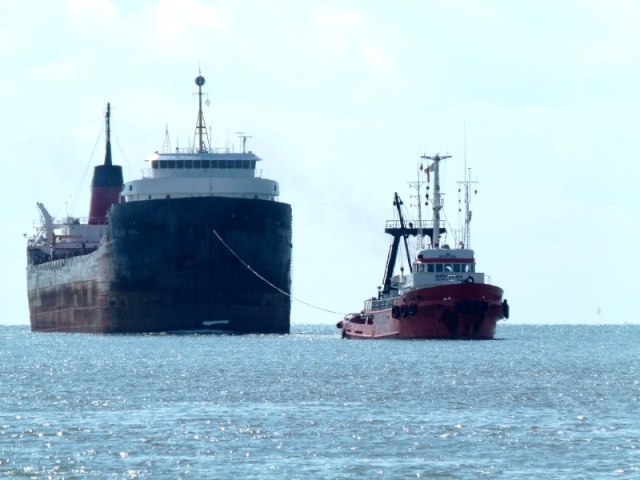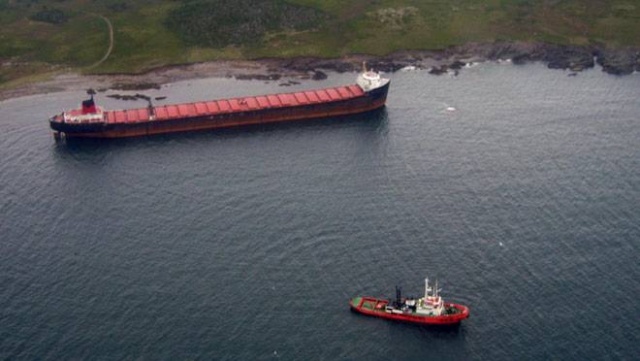For you ship guys, how common is it to see a smit bracket fwd? Fantasy, or a on reality?
[QUOTE=z-drive;133242]For you ship guys, how common is it to see a smit bracket fwd? Fantasy, or a on reality?[/QUOTE]
I’ve never seen one that I can recall.
[QUOTE=Topsail;133234]K.C. You are a very valiant and brave Master. But playing around with the anchor chain of a vessel the size of the SHINYO SAWAKO, is to my humble advice a very difficult task. I worked on a vessel that size and only one (1) chain link weight like 250 pounds ! Can you imagine pulling around any length of that sort of chain in adverse weather conditions. I agree that on much smaller vessels, it worth a very well coordinated try.
Again, a DYNAMICA rope of 1¼ inch diameter has a breaking stress at the splice of 70 metric tonnes and weight 95 pounds per 300 feet of length, whereas a rope of 2½ inch diameter has a breaking stress at the splice of 225 metric tonnes and weight 370 pounds per 300 feet of length. I think it is cheaper to supply a vessel with some kind of ready to use DYNAMICA Bridle Ropes than losing the vessel on the rocks, like it is cheaper to use a tug to dock than welding frames and plates to fix a huge hole in the hull. Not to mention risk of oil pollution. But I’m not convince that office white collars would agree. But if they receive a formal demand in that sense, they will be stuck with it ! CYA is the very fine word.[/QUOTE]
No personal comments pls.
The two points I’ve made upthread are that ship’s crews lack expertise in being towed and a salvor crew should be put aboard. I would think this would be even more the case with a big tanker given the weights, forces and consequences involved. The other point is the captain should be guided by the ship’s Emergency Tow Plan.
I don’t know about towing big tankers but as far as moving heavy anchor gear, a ship with heavy gear is going to have more powerful anchor machinery. A competent crew should be able to move the anchor gear on deck using power without too much trouble provided farileds etc are chosen properly…I would think it would be the I same with the AHTS, I would guess that if it can’t handle the anchor gear it might not be able to handle the tow.
Of course adverse weather changes everything, how many times does that need to be said?
[QUOTE=z-drive;133241]Do you means dyneema? If so its fun to play with and have used it as a bridle successfully.
A good customer will have dyneema/spectra tow gear ready to go shoreside a helicopter ride Away.[/QUOTE]
Exact, Dyneema Fibres manufactured by Dynamica Rope … not the other way around ! 
http://www.secondair.com.au/dynamicarope/drange.htm#properties
… Sorry, I admit that my English could be better ! :o
[QUOTE=Kennebec Captain;133245]No personal comments pls.
[/QUOTE]
![]()
Sir Yes Sir !
[QUOTE=z-drive;133242]For you ship guys, how common is it to see a smit bracket fwd? Fantasy, or a on reality?[/QUOTE]
The arrangement I saw as a pilot to tow a 700 footer dead ship through hundreds of miles of narrow channel before thousands of miles of open seas was, Smit Towing Brackets and Smit Fairleads not welded on the forecastle deck but on the main deck. Then the anchor chain bridle passing through openings practiced on each side of the bow (cheek) plating. A CG requirement I suppose …
![]()
Keep towing, maybe one day you will see that !
Z Drive,
[I]How does that Dyneema hold up as a bridle? You use it on heavy tows or light tows? [/I]
The covering jacket chafes pretty easily in my experience, and I would hate to use it if something cheaper is at hand.
Separately …
For the original post, the question did not specify tankers or mention a specific ship
1000 mi emergency tow
30 ft seas may be experienced
20 minute hookup
950 ft
no rudder control but centered and subject to kiting or running / yawing
Obvious answer to the question posed … Have the ship pass chain to the tug and plenty of it, and hook up the towline using the method tug sailor mentioned. If it is sloppy it will get a little tricky on the back deck, but work carefully and get it in the hook as fast as you can safely manage it, then deal with the connection. If it is real sloppy, well, that ain’t gonna work and think what to pass UP.
I cannot see the towed ship’s crew rigging up and making fast a 2-1/4 in dia wire pennant in figure eight fashion around two sets of bits in anything that approaches “quickly.” Is it done? Sure, with a lot of cussing, tools and time.
Now obviously there are beaux coup good ways to connect a tow. If they ARE a tanker with Emergency Towing Arrangement, they should have a strong point and a chain with pear link long enough to at least get out a closed chock. And that changes the whole dynamic back to what to pass TO the ship.
Surely the “real” answer when emergency strikes is to use whatever will work best — or you can make work at all — from the assortment of gear you have at the moment.
And I think that was mentioned too …
SMIT brackets and fairleads no, but have seen strongpoint pad eyes fitted forward on ships in service.
[QUOTE=Topsail;133250]The arrangement I saw as a pilot to tow a 700 footer dead ship through hundreds of miles of narrow channel before thousands of miles of open seas was, Smit Towing Brackets and Smit Fairleads not welded on the forecastle deck but on the main deck. Then the anchor chain bridle passing through openings practiced on each side of the bow (cheek) plating. A CG requirement I suppose …
![]()
Keep towing, maybe one day you will see that ![/QUOTE]
In the 39 years I sailed, I was on 15 or so rescue jobs. 5 were in flat calm and 80 degree weather. The rest were up to our asses in 45 degree water hustling pigiron. I would have loved to pass a prefabricated bridle to a Smit bracket. I retired 5 years ago and hadn’t towed anything in 12 years. It seems the gear has lessened in bulk.
I’ve been on many tows of old LIBERTYs, VICTORYs, T2s and T2 converted SEATRAINs to the bone yard. We used both bridles and chain pigtail through the bullnose. Vessels of this relatively narrow beam towed just fine through the bullnose. Even the 3 rescue 800 or so footers I was on towed fairly well through the bullnose, but that was only to an offshore anchorage.
I have the conn of that dead ship towing operation …

We can see the steel towing line directly through the nose, no chain bridle …

The result, a week after I got off …

The end …

[QUOTE=Topsail;133281]The result, a week after I got off … ][/QUOTE]
Yeah, a week after you got off. A likely story!
@Topsail - This thread is about emergency ship towing. Read the first post.
[QUOTE=Kennebec Captain;133283]@Topsail - This thread is about emergency ship towing. Read the first post.[/QUOTE]
Don’t you think that at a certain point, that towing changed from a regular to an emergency one ! 
[QUOTE=Topsail;133284]Don’t you think that at a certain point, that towing changed from a regular to an emergency one ! ;)[/QUOTE]
Don’t you think that at a certain point you should start a new thread for a new topic?
Moran towed the infamous barge NEW YORK with 5K to 6K hp for 30 years. She was just over 500 ft, 34 ft draft, 250,000 bbl notch barge. She had a spoon bow with a nose ring. I don’t remember the sizes but attached to the ring was 300 ft very large braid for loaded tow shock line. 500 ft 12 inch braid for the emergency tow hawser with a pick-up buoy and a wire pennant for wire to wire light barge tow. We parted the towline twice in the 14 years I worked her. That was in some pretty severe storms. We recovered her with minimal loss of hide.
When Crowley picked up the barge, one of their management guys laughed at our lack of seamanship. He went on to install a massive chain bridle and they towed with twice the HP. I think they gained 1 kt. Several guys were injured wrestling the chain to hook up. I saw them a couple of years later just before the barge was sold. They had a single chain pigtail on the nose ring.
It’s tough to generalize with all of the variables.
Bridles have their place depending on the hull.
[QUOTE=injunear;133429]Moran towed the infamous barge NEW YORK with 5K to 6K hp for 30 years. She was just over 500 ft, 34 ft draft, 250,000 bbl notch barge. She had a spoon bow with a nose ring. I don’t remember the sizes but attached to the ring was 300 ft very large braid for loaded tow shock line. 500 ft 12 inch braid for the emergency tow hawser with a pick-up buoy and a wire pennant for wire to wire light barge tow. We parted the towline twice in the 14 years I worked her. That was in some pretty severe storms. We recovered her with minimal loss of hide.
When Crowley picked up the barge, one of their management guys laughed at our lack of seamanship. He went on to install a massive chain bridle and they towed with twice the HP. I think they gained 1 kt. Several guys were injured wrestling the chain to hook up. I saw them a couple of years later just before the barge was sold. They had a single chain pigtail on the nose ring.
It’s tough to generalize with all of the variables.
Bridles have their place depending on the hull.[/QUOTE]
Good post. The subject of “know how” a crew develops over time could be a separate thread. Sometimes these smart lawyer types place too much faith in the text book and underestimate how much high quality knowledge a crew can build up. Simple trial and error can be a powerful teacher and it adds up over time.
Here is a new test question class:
You are the master of a huge behemoth of a tug/icebreaker told to get a high profile very specialized rig out out of port in a short time frame into some of the most horrible North Pacific winter weather seen in that part of the world for many years. Which of the following statements are correct for the situation
- demand more time to ensure extra heavy tow gear is available and properly rigged along with emergency tow recovery equipment?
- demand that you have final right to chose the route of the tow including the right to stop to await storm conditions to pass?
- demand that a second large tug accompany you in case their might be some problem enroute?
- fully agree with the findings of all the numerous “towing” experts who insist that “nothing can go wrong”?
- have no qualms lying in any subsequent USCG hearings?
a. answers 1 , 2 and 3 are correct
b. answers 4 and 5 are correct because you believe they are correct
c. answers 4 and 5 are correct because the owner tells you they are and that you will find yourself on a flight home it you don’t say "of course, Mister “insert company owner’s first name here”
no looking on the other student’s papers or passing answers!
.
You can get it for $2.50 on Amazon used books, great read!
In Peril: A Daring Decision, a Captain’s Resolve, and the Salvage that Made History Paperback – January 1, 2005
by Skip Strong (Author), Twain Braden
Strong and Braden’s tale of an imperfect storm, three ships and a daring rescue comes to vivid life in this gem of a book. Strong, captain of an oil tanker carrying 10 million gallons of crude, was trying to outrun tropical storm Gordon when he picked up a distress call off the Florida coast in the early hours of November 15, 1994. An oceangoing tug with a cargo barge tethered behind it had lost engine power and was foundering. Strong decided to attempt a rescue, although doing so put his own crew and cargo, not to mention hundreds of miles of Florida coast, at risk of a catastrophic oil spill. Strong also didn’t know that the barge’s cargo, a brand-new external fuel tank for a space shuttle, was worth nearly $50 million. The successful rescue of all life and property later resulted in a landmark judgment in court when the company that owned Strong’s ship claimed, via long-standing maritime laws, the right to a percentage of the value of the rescued goods. Strong’s first-person narration of the immediate story is gripping, while still allowing for discursions into topics such as shipping, admiralty law and meteorology. Strong and co-writer Braden don’t rush into the high-seas drama, but the complex details involved in the rescue itself are sharp and clear. The court case is anticlimactic, but the authors don’t linger on it unnecessarily. This is a great story, well told. Photos.
Copyright 2003 Reed Business Information, Inc. --This text refers to an out of print or unavailable edition of this title.
I read that book, thought it was a great read as well. Let someone borrow it, and haven’t seen it since. Go figure.
[QUOTE=c.captain;133534]Here is a new test question class:
You are the master of a huge behemoth of a tug/icebreaker told to get a high profile very specialized rig out out of port in a short time frame into some of the most horrible North Pacific winter weather seen in that part of the world for many years. Which of the following statements are correct for the situation
- demand more time to ensure extra heavy tow gear is available and properly rigged along with emergency tow recovery equipment?
- demand that you have final right to chose the route of the tow including the right to stop to await storm conditions to pass?
- demand that a second large tug accompany you in case their might be some problem enroute?
- fully agree with the findings of all the numerous “towing” experts who insist that “nothing can go wrong”?
- have no qualms lying in any subsequent USCG hearings?
a. answers 1 , 2 and 3 are correct
b. answers 4 and 5 are correct because you believe they are correct
c. answers 4 and 5 are correct because the owner tells you they are and that you will find yourself on a flight home it you don’t say "of course, Mister “insert company owner’s first name here”
no looking on the other student’s papers or passing answers!
.[/QUOTE]
Need details, “most horrible weather” is what sea ht and wind speed, “extra heavy tow gear” in tons SWL please , what do I have to lie about to the CG and is that flight coach or business class?